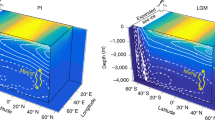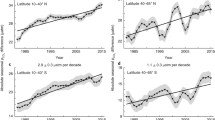Abstract
Based on LGM experiments with an atmosphere–ocean general circulation model, we systematically investigated the effects of physical changes in the ocean and induced biological effects as well on the low atmospheric CO2 concentration (pCO2) at the last glacial maximum (LGM). Numerical experiments with an oceanic carbon-cycle model showed that pCO2 was lowered by ~30 ppm in the LGM ocean. Most of the pCO2 reduction was explained by the change in CO2 solubility in the ocean due to lower sea surface temperature (SST) during the LGM. Moreover, we found that SST changes in the high-latitude Northern Atlantic could explain more than one-third of the overall change in pCO2 induced by global SST change, suggesting an important feedback between the Laurentide ice sheet and pCO2.




Similar content being viewed by others
References
Adkins JF, McIntyre K, Schrag DP (2002) The salinity, temperature, and δ18O of the glacial deep ocean. Science 298:1770–1773
Archer D, Winguth A, Lea D et al (2000) What caused the glacial/interglacial atmospheric pCO2 cycles? Rev Geophys 38(2):159–189
Bopp L, Kohfeld KE, Quere CL et al (2003) Dust impact on marine biota and atmospheric CO2 during glacial periods. Paleoceanography. doi:10.1029/2002PA000810
Braconnot P, Otto-Bliesner B, Harrison S et al (2007) Results of PMIP2 coupled simulations of the Mid-Holocene and last glacial maximum—part 1: experiments and large-scale features. Clim Past 3:261–277
Brovkin V, Ganopolski A, Archer D et al (2007) Lowering of glacial atmospheric CO2 in response to changes in oceanic circulation and marine biogeochemistry. Paleoceanography 22:PA4202. doi:10.1029/2006PA001380
CLIMAP (1981) Seasonal reconstruction of the earth’s surface at the last glacial maximum. Tech. Rep. Map and Chart Ser. MC 36, Geol. Soc. of Am., Boulder
K-1 Model Developers (2004) K-1 coupled model (MIROC) description. K-1 Tech. Rep. 1, Cent. for Clim. Sys. Res., Tokyo
Kim SJ (2004) The effect of atmospheric CO2 and ice sheet topography on LGM climate. Clim Dyn 22:639–651
Köhler P, Fischer H, Munhoven G et al (2005) Quantitative interpretation of atmospheric carbon records over the last glacial termination. Global Biogeochem Cycles. doi:10.1029/2004GB002345
Otto-Bliesner BL, Hewitt CD, Marchitto TM et al (2007) Last glacial maximum ocean thermohaline circulation: PMIP2 model intercomparisons and data constraints. Geophys Res Lett 34:L12706. doi:10.1029/2007GL029475
Peacock S, Lane E, Restrepo JM (2006) A possible sequence of events for the generalized glacial-interglacial cycle. Global Biogeochem Cycles. doi:10.1029/2005GB002448
Sarnthein M, Winn K, Jung SJA et al (1994) Changes in East Atlantic deepwater circulation over the last 30, 000 years—8 times slice reconstructions. Paleoceanography 9:209–267
Schmittner A (2003) Southern Ocean sea ice and radiocarbon ages of glacial bottom waters. Earth Planet Sci Lett 213:53–62
Schmittner A, Galbraith ED (2008) Glacial greenhouse-gas fluctuations controlled by ocean circulation changes. Nature 456:373–376
Sigman DM, Boyle EA (2000) Glacial/interglacial variations in atmospheric carbon dioxide. Nature 407:859–869
Toggweiler JR, Gnanadesikan A, Carson S et al (2003a) Representation of the carbon cycle in box models and GCMs: 1. Solubility pump. Global Biogeochem Cycles 17(1):1026. doi:10.1029/2001GB001401
Toggweiler JR, Gnanadesikan A, Carson S et al (2003b) Representation of the carbon cycle in box models and GCMs: 2. Organic pump. Global Biogeochem Cycles 17(1):1027. doi:10.1029/2001GB001401
Yamanaka Y, Tajika E (1996) The role of the vertical fluxes of particulate organic matter and calcite in the oceanic carbon cycle: studies using an ocean biogeochemical general circulation model. Global Biogeochem Cycles 10(2):361–382
Yu EF, Francois R, Bacon MP (1996) Similar rates of modern and last-glacial ocean thermohaline circulation inferred from radiochemical data. Nature 379:689–694
Acknowledgments
We are grateful to two anonymous reviewers for thoughtful comments and discussion which improved the manuscript. This study is supported by JSPS Research Fellowship for Young Scientists.
Author information
Authors and Affiliations
Corresponding author
Rights and permissions
About this article
Cite this article
Kurahashi-Nakamura, T., Abe-Ouchi, A. & Yamanaka, Y. Effects of physical changes in the ocean on the atmospheric pCO2: glacial-interglacial cycles. Clim Dyn 35, 713–719 (2010). https://doi.org/10.1007/s00382-009-0609-5
Received:
Accepted:
Published:
Issue Date:
DOI: https://doi.org/10.1007/s00382-009-0609-5




